When you enroll in the Conservation Reserve Program (CRP), there is a long list of conservation practices, or CPs, that you can put into action to improve the condition of your land.
One of the most common CPs is known as a conservation buffer. Conservation buffers, also called buffer strips, can not only enhance your farmland but provide environmental and economic benefits as well.
Here, we will discuss the many advantages of conservation buffers and how you can begin to establish them on your farm.
What is a conservation buffer?
Conservation buffers are strips of land established around row crops. These areas are strategically planted with permanent vegetation, often native species, to intercept sediment, pollutants, and nutrients to improve waterways. Additionally, they protect the health of the soil and provide other environmental benefits.
There are different types of buffer strips that can be used for a variety of purposes. For example, contour grass strips can be grown to reduce wind, while filter strips are planted to slow water runoff. Grass waterways, riparian buffers, and prairie strips are other commonly used buffer strips. Many CRP practices are specifically designed to implement these buffers.
How do conservation buffers benefit your land?
Protect marginal land
Through CRP, conservation buffers can be established to protect marginal land that is prone to erosion issues. These areas are typically also lower yielding land due to the loss of topsoil through erosion.
Planting buffer strips in these vulnerable areas helps stabilize the land and improve the health of the soil. In turn, the land stays out of agricultural production, so it has time to recover and restore.
Reduce soil erosion
In addition, buffer strips also improve the soil on your land by reducing erosion. The grasses, shrubs, and trees that are planted as conservation buffers cover and protect the soil from wind, rain, and ice.
They help prevent all different types of erosion, including sheet, rill, and gulley erosion. Ultimately, the more erosion can be reduced, the better the health of the land for future production. Since the US is currently running out of soil, protecting vulnerable soil is one of the top priorities of many conservation efforts today.
Improve water quality
Buffers like filter strips and riparian buffers are used to trap runoff before it enters streams, rivers and lakes. They are also efficient at slowing water flow to further limit runoff. This prevents sediment, pesticides, and other harmful pollutants from contaminating nearby water sources.
By using conservation buffers, studies have shown that more than 75% of sediment can be removed from runoff, as well as 60% of pathogens and 50% of harmful nutrients and pesticides.
Establish wildlife habitat
The grasses, trees, and other species planted as buffer strips also help enhance the local wildlife habitat. Native species are particularly beneficial, as they have evolved over thousands of years to survive in their region.
Since they are already adapted to these plants, local wildlife can benefit significantly from the habitat provided by native species. In particular, buffers can boost crucial pollinator habitats, whose current habitat is dwindling at an alarming rate. As pollinators contribute to the fertilization of more than ¾ of the world’s flowering species, providing them with a stable habitat further secures the world’s food supply.
Promote sustainability
Utilizing conservation buffers is an effective way to incorporate sustainable agricultural practices onto your land. For centuries, crop production has reduced the quality of land all over the world due to overuse. As time goes on, the amount of productive, usable soil diminishes.
To ensure the food supply for future generations, sustainable practices must be used to slow the degradation. By implementing these practices, you can help safeguard the future of agricultural production.
Conservation buffers are sustainable & economically beneficial
In addition to their environmental benefits, conservation buffers offer economic advantages for farmers as well. CRP provides financial incentives for establishing buffers on your land, based on your soil’s productivity and the average rent of similar land in your area. These incentives, as well as cost-share and additional rental payments, are available depending on your state.
To start reaping both the environmental and financial rewards of conservation buffers, reach out to an experienced CRP professional. Our experts at FDCE can assist you with signing up for the program as well as establishing conservation buffers and other CRP projects on your land. Get a free quote to start your buffer strip project today!

